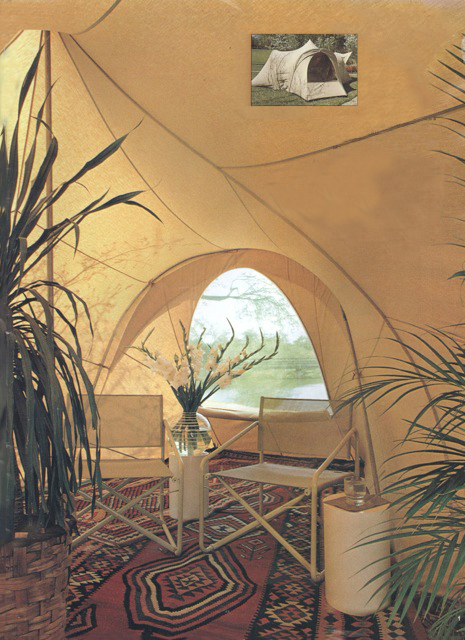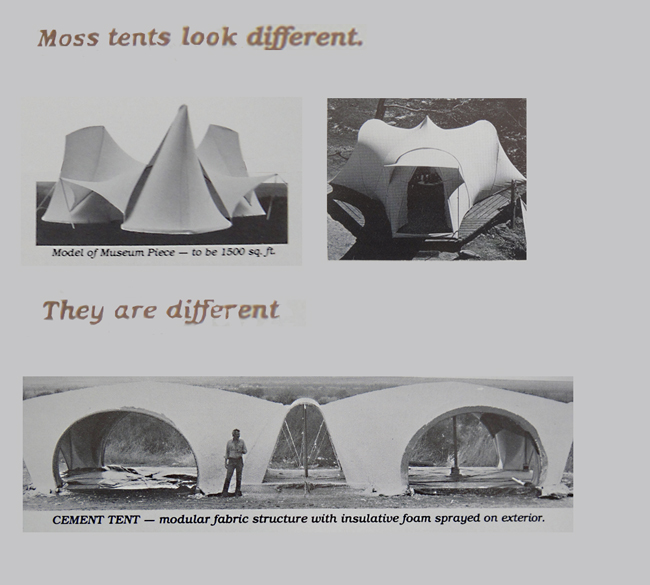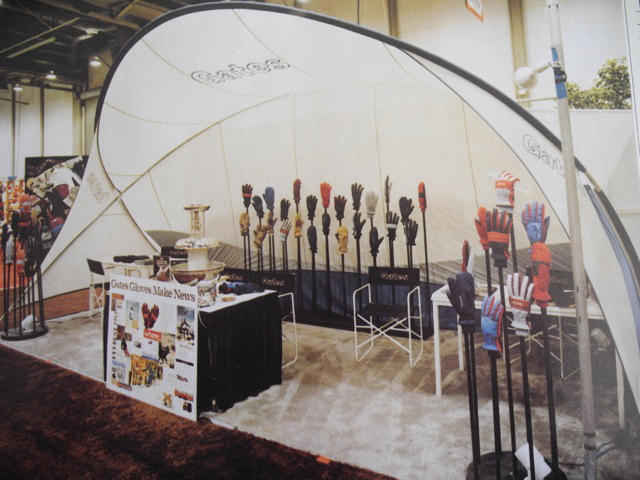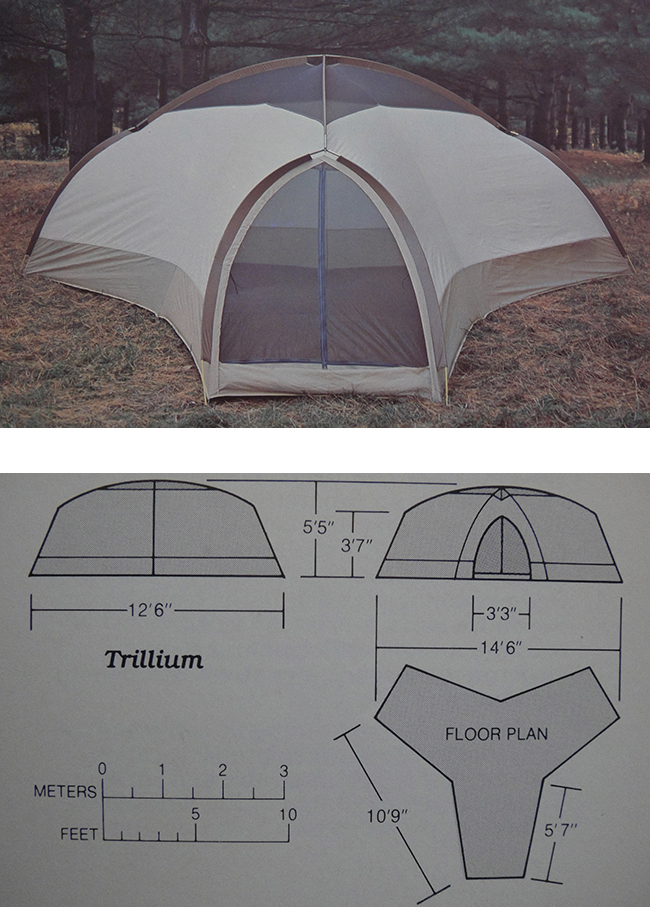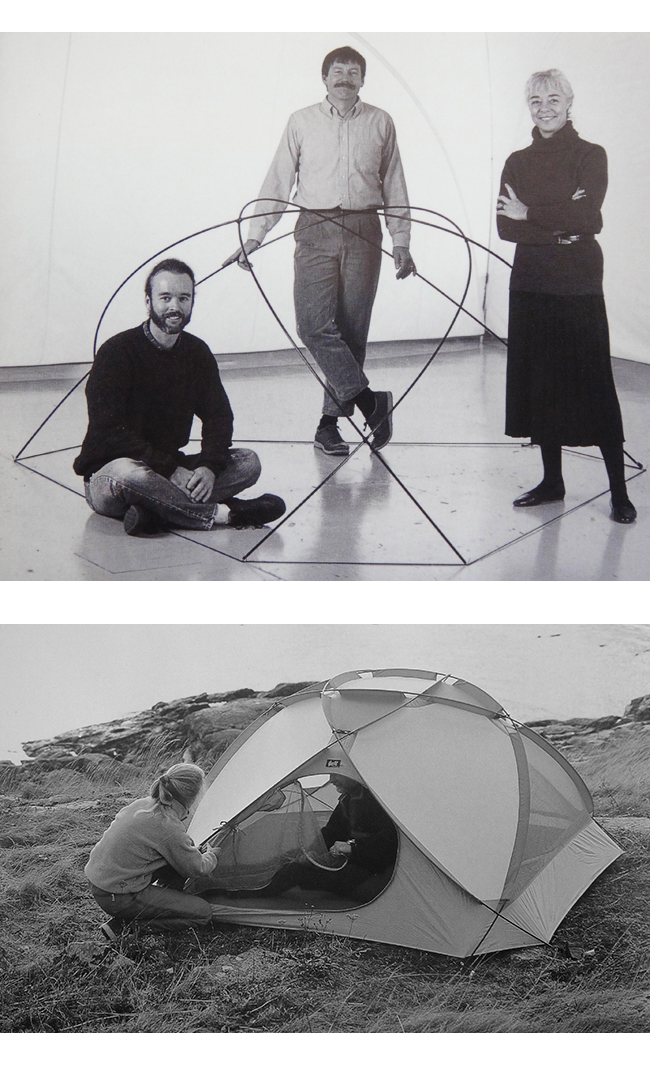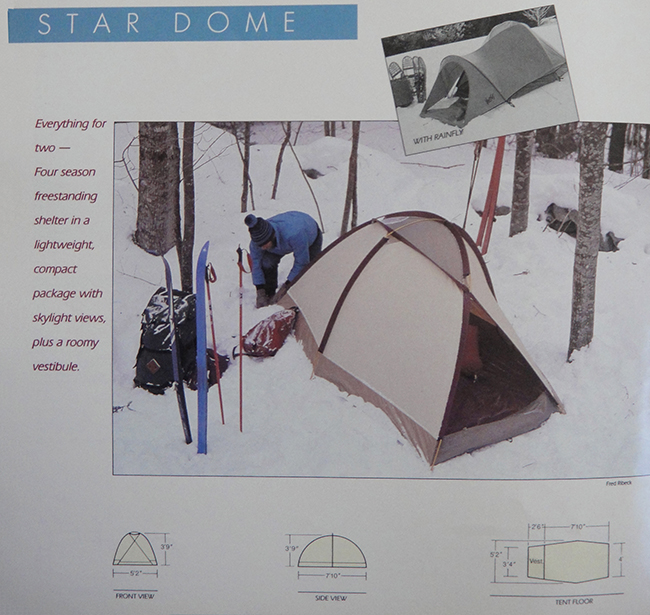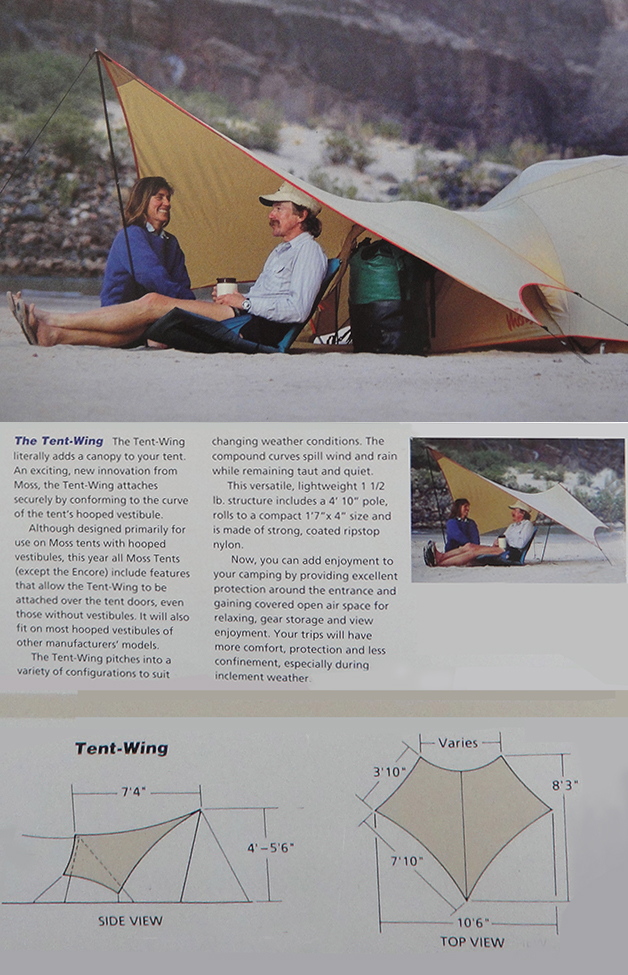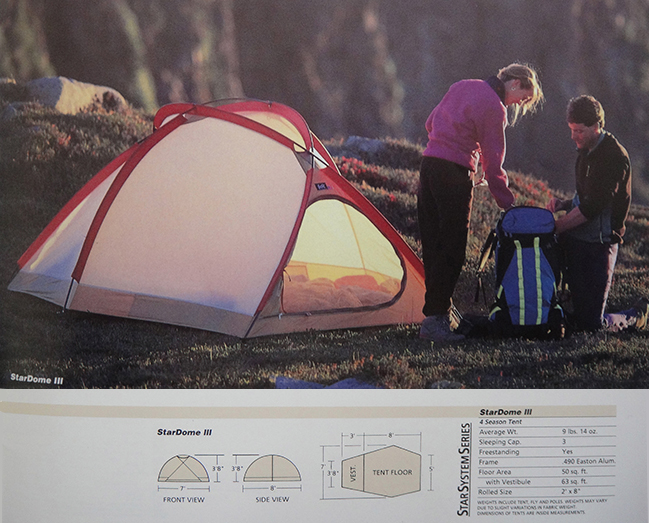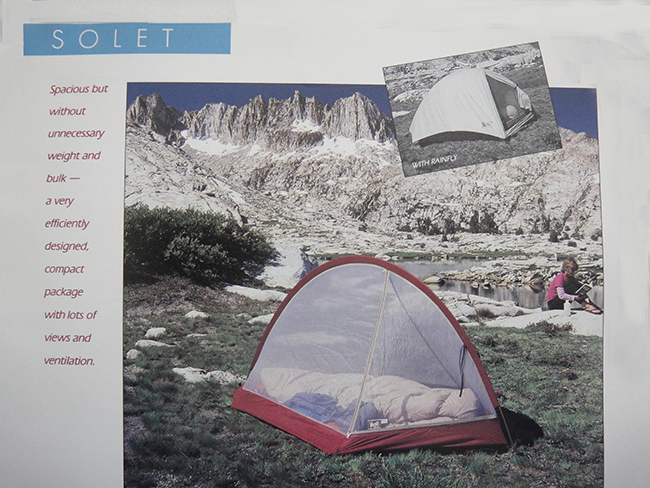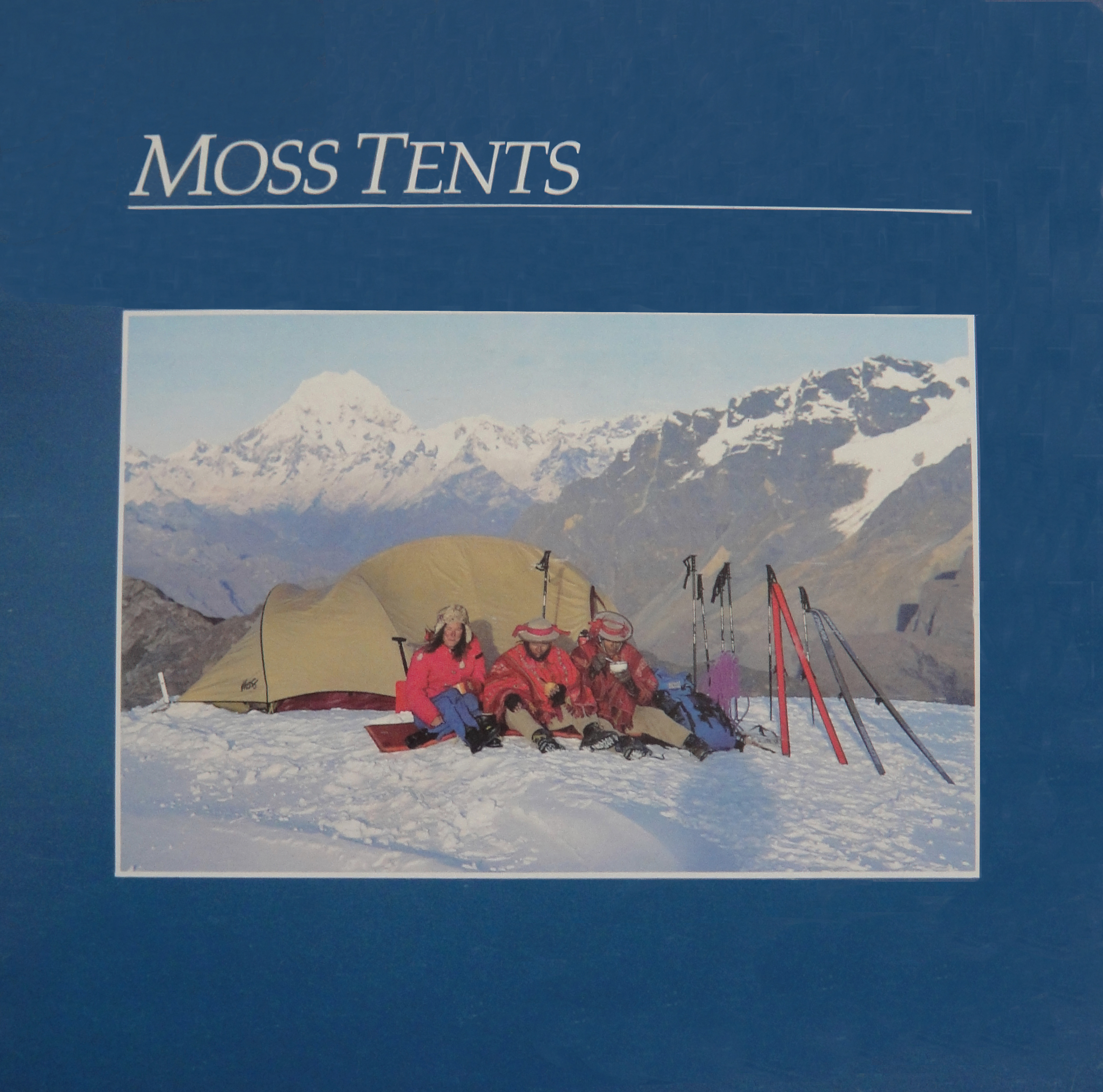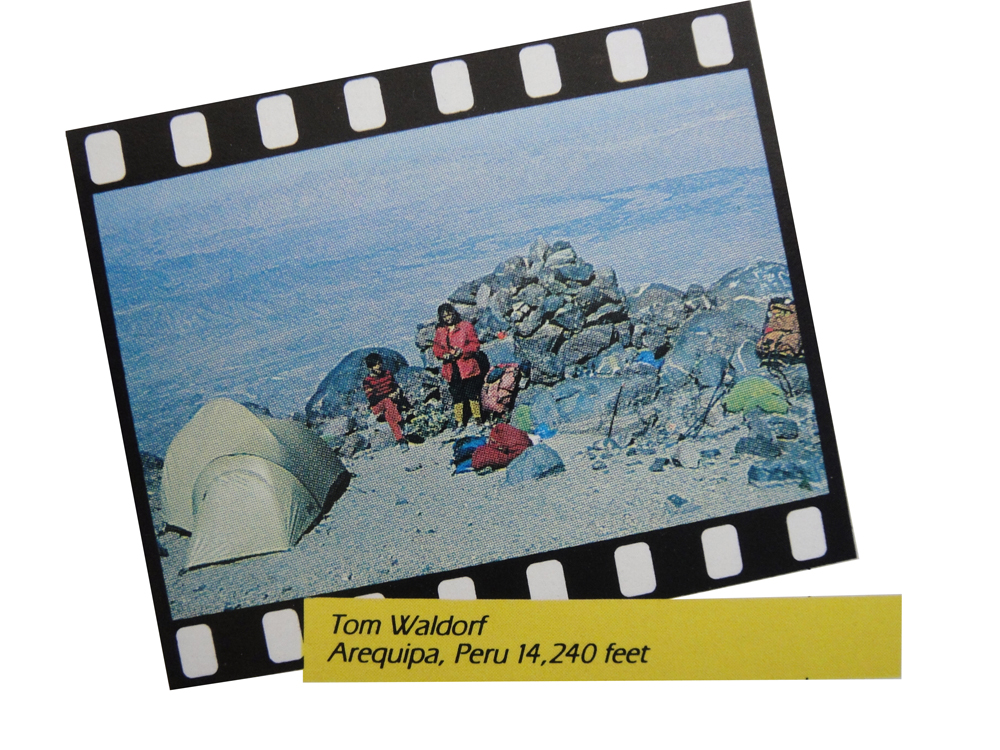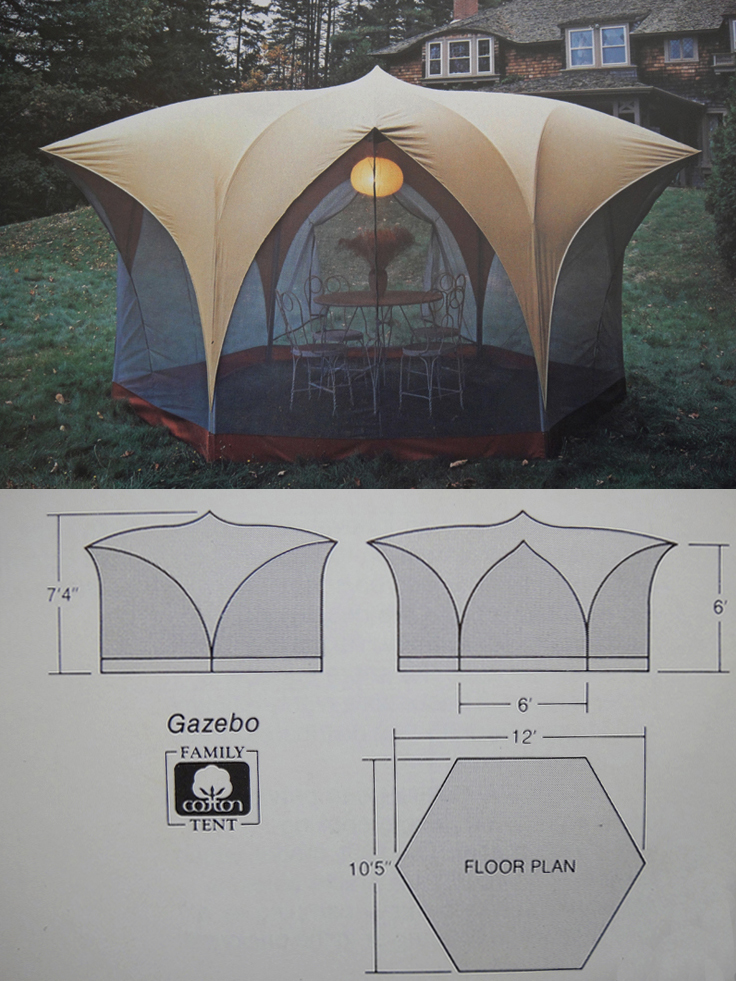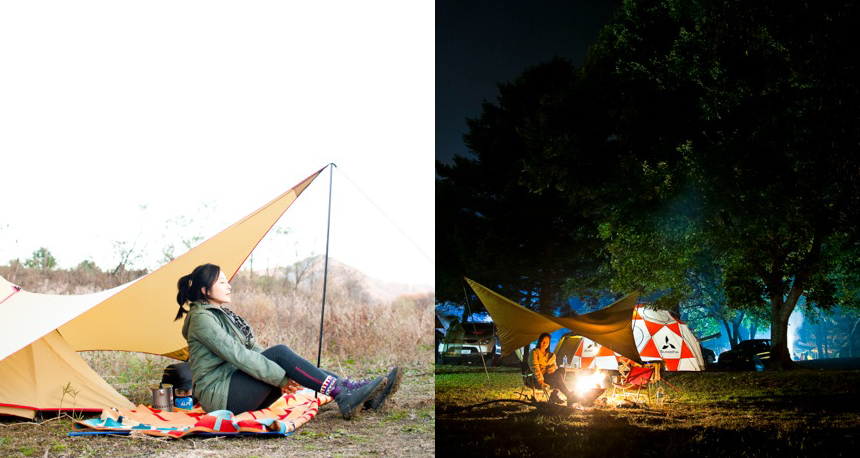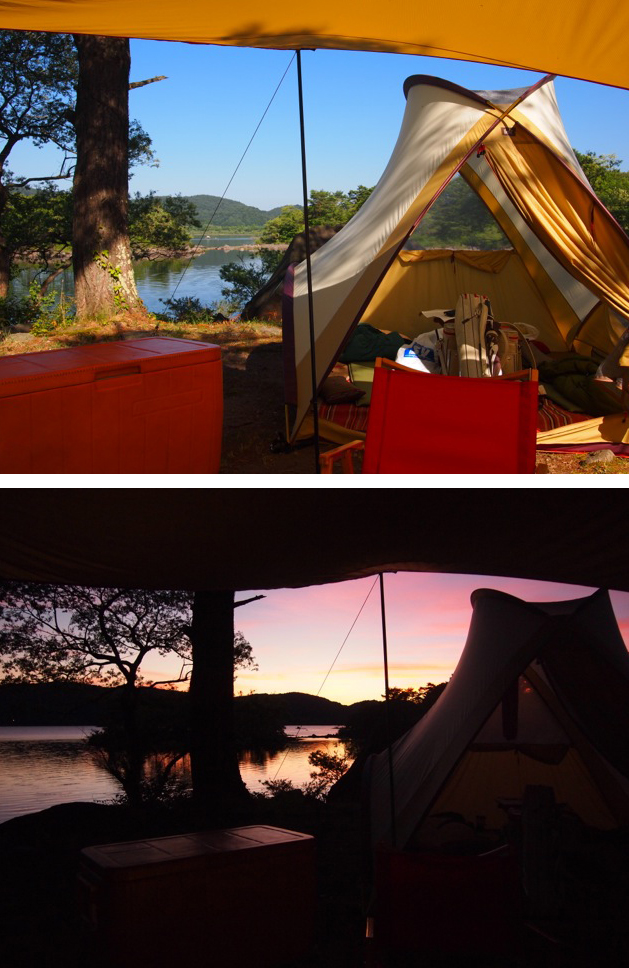Easy Living: The Moss Saddle Gazebo
"Bill and I had invited some staff from Moss Design and many friends to spend a weekend at our dome and beach on the North Shore of North Haven Island, Maine one summer. We had lobster/clam cookouts on the beach. One afternoon, a number of the group gathered old boards and a washed up log from the beach and constructed this deck, cantilevered out over the sandy beach. Later on, Bill designed and the staff made a dining canopy at Moss Tents for the deck. Bill and his staff built the table and stools out of plexiglass and leather cushions. We ate many lunches on the deck and savored many early evenings, sitting with drinks, watching the sun sink behind the Camden hills, leaving a crimson skyline silhouetting the seven humps."
Marilyn Moss
Moss: The Art of Shelter
Moss combined the advantages of tents with new design possibilities to create spaces that could fill varied needs. As we see it, fabric structures are functional aesthetic alternatives to conventional shelter.
Moss Design Group was the design and consulting aspect of our business. MDG specialized in the development and application of tensile structures.
Our custom work included restaurant and outdoor awnings, emergency shelters that could be dropped from aircraft; pavilions for public gatherings; low cost housing; sea expedition tents; survival camping tents, and more.
The Moss Pentawing: the Innovative Alternative to the Conventional Awning
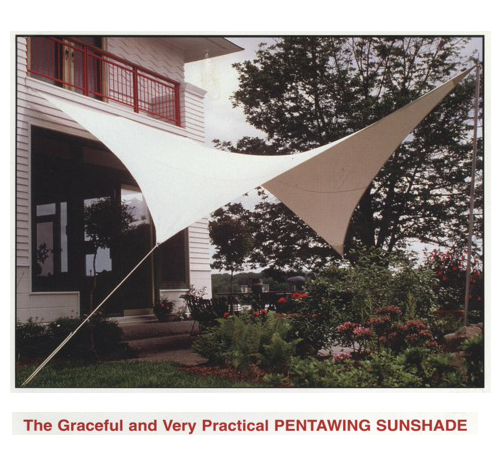 With exclusive tension fabric technology...this unique sunshade created a welcome shelter and energy savings over your deck, terrace, lawn, window, greenhouse or entryway.
With exclusive tension fabric technology...this unique sunshade created a welcome shelter and energy savings over your deck, terrace, lawn, window, greenhouse or entryway.
"Bill Moss originally designed this shade awning in the '60s for John Boyle & Company. It was a modification of his hyperbolic paraboloid shade canopy, called the Parawing. Bill redesigned it at the request of this client to attach to a residential entrance, which required five points instead of four. John Boyle & Company marketed it, the Butterfly Chaser, for backyard sitting/dining, as a sun and light rain shelter. Later, in Camden, Maine, Bill renamed it the Pentawing. The white cotton, elegant shapes started appearing in backyards and commercial entries throughout coastal Maine". Marilyn Moss
The Moss StarGazer Led a Double Life
Back in the '80s the Moss StarGazer enjoyed a new role as an exhibition structure at a trade show for glove manufacture. The space was enclosed yet light, airy and open to the public.
At the time, E. Thomas Willard, Vice President of Gates-Mills, the company that contracted the StarGazer for this show, made the following comments:
"attractive design...ease of erection and knockdown amazed us...functioned very well from a display standpoint...we are not alone in our praise. A spokesman from the National Association of Display Industries...said that our booth represented the best display of product at the show."
Just recently, Tom Willard contacted us with his recollections of that event and of his interactions with Bill Moss in preparation for the exhibit:
Today I revisited my curiosity about what is going on with Moss. I found your book, which I am sure to read. You asked for "a Moss experience", and I have one. I believe it was 1982 when our sales manager and I visited your company. We were producing fabric ski gloves (Gates), and I wanted to use fabric to sell fabric. We met you and worked with Bill during the day. His tour of your camping tents brought me upon the "StarGazer". I asked Bill if you could make it bigger, as in 10'x20' in size. He said yes, but that he would have to build a model because it could not be drawn well. I remember Fred, our sales manager, getting excited, and deciding he could draw it. He stood in the middle of the room, with pencil and paper, when he realized that Bill was right. It was comical. Long story short, you did it and it was a great success for Gates. For you i believe it may have lead to taking an idea or design out of one definition and moving it over to another. From camping to display the same principle works. It was a fun project, and I still have the model, which Bill had made. I keep it with pride as a momento. Good luck with your writing. Itis good to reconnect." Tom
Thank you, Tom, for sharing your memories with us. Marilyn
The Moss Trillium Tent: One of Marilyn Moss' Favorites
"I took the Trillium in the mid '70s to my family reunion in West Virginia. The two kids and I stayed in it in the yard of my grandparents' house I grew up in. Every bedroom was taken with other visiting family members. Genevieve and Jeff were the envy of the other grandchildren. The Trillium with its three alcoves had so much room, it was as though each of us had our own little tent bedroom. Outside of the Olympic, I used this tent the most."
Marilyn Moss
At the Moss Tent Factory, Camden, Maine, 1991
Remembering the Moss Encore Tent
A Classic Moss Tent: The 4 Season Star Dome
"The Star Dome offers a very attractive combination of features--freestanding, four season shelter, screened top window, light weight, small rolled sized, plus a vestibule.
Our lightest four season tent, the Star Dome is extremely strong, stable and easier to pitch on rough terrain because it is freestanding. Ventilation and views are provided for via a large rear window and the usual screened ceiling. The ceiling also has a zippered window flap that can be adjusted to supply just the amount of ventilation you need.
The steeply curved, nearly vertical sidewalls provide a generous useable floor area of 36 square feet. The full coverage rainfly provides optimum weather protection. The vestibule/fly has a separate arch which forms a curve over the door to provide more storage space. It rolls into a compact 1 foot 4 inch by 6 inch package. The Star Dome will provide you comfortable, dependable shelter in a wide variety of conditions with space, views and a vestibule."
Introducing the Moss Tent-Wing, 1992
From the Moss Tents 1992 catalogue:
"The Tent-Wing proved itself during a 4 day stretch of rain. We were able to get out of the tent and to avoid claustrophobia and also cook without getting soaked or inhaling fumes. We love the versatility of being able to use the Moss Tent-Wing by itself."
Jeffrey and Pat Whitaker Colorado
Down Moss Tent Memory Lane: The "Bombproof" StarDome III, Winter Pumori Expedition,1990
From the 1990, Moss Tent Catalogue, Alfred J. Torrisi writes:
"It is no accident that Moss Tents are being used for our expedition! Many of the team members have grown to appreciate the ease of set up, the structural integrity, the roomy feeling and especially the light weight of your products...In fact, the StarDome is a veteran of a Himalayan and two Alaskan adventures...compactness, lightness and ease of assembly of the StarDome (not to mention the fact that it is "bombproof") make it the tent of choice high on the mountain."
Vintage Moss: The Habitual Hiker and His Solet Hit the Appalachian Trail
From the 1987 Moss Tent Catalogue--Leonard Adkins recounts his adventures with the Moss Solet:
"I started hiking the Appalachian Trail northward from Harpers Ferry, W. Virginia on June 3rd of this year. Now, after 500 miles and 140 days of use, the Moss Solet tent looks and performs as well as it did the first night I used it in Harpers Ferry over four months ago...
I came to love the simplicity of design and ease of set up of the Solet. New England had the wettest summer in 97 years this year. Since it rained so much, I would push my luck almost to the ver last second and keep hiking in order to cover as much distance as possible before the rains began.
At Clearwater Brook, Maine, I was racing against a thunderstorm and I timed myself putting up the Solet. From the moment the Solet came out of the stuff sack until the last stake for the fly was in the ground, I took only one minute and 53 seconds to set the tent up....Through all this rain I never got wet...
On Flagstaff Lake, Maine, I once again came to appreciate the no-see-um body of the tent...the night was clear and cool...I left the fly off so that I could enjoy the magnificent display of stars...Yet, I was protected from the hordes of insects.
That morning a fierce storm rolled in over the lake. I put the fly on and listened to the storm from inside the tent...I could tell I was in a violent storm upon breaking camp in the morning, I saw where the wind had brought down a number of trees and cracked branches off of others. I had made it through the storm nice and dry. I, in fact, had not really had any idea how fierce the wind had been as all through the storm the tent and even the fly remained solid with barely a perceptible flapping of the fly..."
We would love to hear about your experiences with the Moss Solet.
Thanks, Marilyn
Dreaming of Warmer Weather and the Moss Parawing
Ah, to be outside under the protection of the Moss Parawing.....
Bill Moss' design for the Parawing made a big difference between an enjoyable vacation and one that was wet and miserable. The Moss Parawing was one amazing innovation. Unlike a conventional tarp/dining fly, the Parawing hyberbolic paraboloid compound curves offered more protection and strength by facilitating the spilling of wind and rain.
The 12' model could provide weight conscious campers with ample cooking and dining shelter...while the 19' model was especially suited to family camping as a dining fly, or for added flair and protection at picnics, barbecues or parties at home or on the beach.
(paraphrased from the 1987 Moss Tent Catalogue)
Happy New Year!
Expedition Tres Cumbres: Adventures in the Moss Olympic Tent, South America, 1986
From the Moss Tent 1987 catalogue, a tale of the Moss Olympic Tent in the early years:
"It sounded like the mountain troops were holding midnight machine gun practice at "Nido de Condores," our glacial tent platform on Nev Illimani, Bolivia...difficult enough to "sleep" at 5,00 meters without listening to the rainfly of the Argentine climbers' tent flapping loudly in the high, gusty winds outside. By contrast, the walls of our Moss Olympic tent barely vibrated, since they were stretched tightly between lightweight but rugged aluminum glacier tent stakes.
Even "rocked down" (without tent stakes) as tightly as we could, our Moss Olympic provided tight, welcome shelter at Camp II (6,520 m.) just below a rocky, windswept summit of Bolivia. Three climbers could sleep comfortably warm; two with generous extra space. Normally, we used our rainfly vestibule to store important gear needed for moonlight "alpine starts" for summit days. But on the high, wide and exposed glacial platform at "Nido de Condores," Nevado Illimani (6,462 m.) we had practically no choice but to cook inside the vestibule.
With a zippered door at either end, access to the functional vestibule was by simply opening the zipper, enabling us to cook only a foot or two from our "pillows." After having owned 5-6 other tents of varying designs in the past, I can truly testify that our Moss Olympic, with its tight aerodynamic design, was in a class by itself. It was the envy of many other climbers from many other nations who examined it."
Tom Waldorf Bozeman, Montana Expedition Tres Cumbres
Peru, Chile, Bolivia 1986
Bill Moss Tents Were Not Just For Camping
From the 1980 Moss Tent catalog:
"The Gazebo [was] a stable, graceful alternative to the conventional "screen house." Four six foot arches covered with fine no-see-um netting, allowed breezes through and kept bugs out. The Gazebo [had] no sewn in floor so it wouldn't leave brown spots on a lawn.
Once you have experienced the refreshing difference of graceful, light filled curves, you may never want to return to an existence in straight lines and curves."
What are your memories of the Moss Gazebo?
Marilyn
Merrill's 28 Year Old Moss Starlet Still Feels Bombproof
This just in from Merrill, a devoted fan of the Moss Starlet:
"I have a Camden Maine-tagged Moss Starlet tent I lived in almost every night on my 28,000 mile, 28 country world bicycle tour from 1984-1988. I pitched this tent at least 1200 times. Sent it back to Moss Tent Works in 1988 to replace worn pole sleeves and a pole section and a zipper. Still going strong after 28 years!
 You can see in the picture that my Starlet still looks very good, even though it's been pitched at least 1200 times. You might also note the faint "camouflage" effect showing through the fly. That is because I painted the other side. On my world tour, my Starlet's tan color stood out too much in very green countries such as Scotland.
You can see in the picture that my Starlet still looks very good, even though it's been pitched at least 1200 times. You might also note the faint "camouflage" effect showing through the fly. That is because I painted the other side. On my world tour, my Starlet's tan color stood out too much in very green countries such as Scotland.
While I was staying the night at a B&B in Inverness, Scotland, I was wondering how I could camp with more of a "stealth" profile, and came up with the idea of painting the non-coated side of the fly with camouflage colors. Since it's symmetrical, the fly fits fine either side out. So I visited an art supply store and bought a throw away brush and two tubes of acrylic artist's paints, one in dark brown and one dark green (the Starlet already has the light tan third color of most camouflage patterns).
Much to my B&B hostess' delight and interest, I set up my Starlet in her back yard, fly wrong side out, and proceeded to paint an abstract camouflage pattern on my tent fly. Acrylic artist paint won't harm nylon and sticks reasonably well to the uncoated side of a fly if you don't brush in on too thick. It worked better than I dreamed. A few days later, I set up my tent not five feet from a sidewalk on the outskirts of a Scottish village. The spot was the only flat area I could find, and was just lightly screened by a few trees and shrubs, but it was still daylight and I wondered how visible I'd be. Dozens of people walked by and no one noticed my tent it blended so well! The picture here shows the coated, normal side out. The green, brown, and tan camouflage pattern is still usable today with the fly wrong side out (but I didn't need it here).
I really came to appreciate the Starlet's small, but completely usable size (for one anyway). I bought it in 1984 before a Moss footprint was on offer, but I had a seamstress sew my own custom footprint with loops at each corner to fit the stakes (you can just see it below the still original red tent floor). I designed it with an extended flap covering the right half of the vestibule so I could put down my food prep things on a clean surface. I cooked many meals in that vestibule, during weeks of rain in Newfoundland, Wales and Ireland, and I stayed dry. It weathered 60 mph winds and horizontal rain in Gros Morne National Park, Newfoundland, Canada. I bicycled across the treeless, rainy, wind swept Hardangervidda in Norway and the Starlet never flapped or complained. It sheds wind like the engine nacelle struts on jet liners!
I recently researched online to see if there were any tents I liked better than the Starlet. I didn't find one. I think I'll keep using mine. I am certainly grateful that Moss Tent works was around in 1988 after my world tour to replace the worn pole sleeves and a zipper. My Starlet still feels bombproof. " Merrill
How great that the Starlet is still going strong. Thank you, Merrill.
Marilyn
A Message from Korea Regarding MOSS and Greatness
We just received the most delightful email from Jin in Korea. Here are some excerpts:
"Even though he is not here on earth with us together, but all his work and tents remain as a legacy in legendary form. That’s all that matters I think....As one of big fans of all MOSS tents around the world, I want to share some story about myself with MOSS tent, and some thought as well that happens the other side of the globe (from where you are).
Long time back to 2005, that was the year that I encountered with MOSS tent very first time of my life. I know you would be very surprised about this but believe me, MOSS tent was not even introduced in Korea that time yet. J I was travelling to Seattle for some business and a weekend, I just popped up and went to Mt. Rainier. Nothing has been planned for that trip to Mt. Rainier back then but I just went there, and that was the place that I first saw MOSS tent, Olympic.
At first site, I would say that I fell in love with it and decided to talk to the guy who was doing camping, to sell it to me. I know it sounds crazy and I don’t even know what sort of courage it was, but anyway, that made a deal with that guy and couple days later, I was one a plane back home with my first MOSS tent…
I liked MOSS tent so much because of its design, fabric, and usability. I want to confess first that I didn’t have much idea about how much effort or energy might be needed to create such a great tent back then. But as I study more about architecture, design, and fabric, I started realizing that all these MOSS tents are the result of one great mind in this planet.
Even though I didn’t have luxury to talk to him directly because of my ignorance at 1990 and early 2000, but having his legacy and enjoying camping with it are such a joy of my life...
What really matter is that people should appreciate the fact that we had Bill Moss on this same planet and because of that we now can enjoy camping with his legendary artwork as a legacy. We do have great tents that he made, came from all the curves and shapes of nature, and that’s what we should appreciate and enjoy...” Jin
Thank you, Jin. Marilyn
The Best Tent I Ever Had
Driftwater Productions shared this video of Barry King, captain of the schooner Mary Day in Camden, Maine. Hear Barry's heartfelt Moss Tent testimonial. http://vimeo.com/49988346
Thank you, Barry, and thank you Driftwater Productions.
Marilyn
The Flower of Life
We received word from Nao-san who sent a photo from a recent camping expedition with his son. They pitched the Moss Encore Tent at a campground by lake Hibara in Japan, a favorite spot of theirs for the past 11 years.
Of Bill Moss tents, Nao-san writes:
"I have been so impressed by Bill Moss products. I am not a musician (though I played keyboards in teenager) but I like artistic products. I know Bill called a top window of his tens as vesica piscis. I know it came from "Flower of Life" in sacred geometry. Though I do not know about it well, I love Bill's products influenced from such mysterious things. When I see stars through vesica piscis, I always feel and enigma of human life and this universe. No other tents let me think about such things."
Thank you, Nao-san, for your beautiful words.
Marilyn
